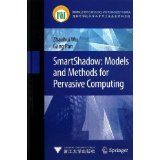 [内容简介]
[内容简介]
《智能影子——普适计算模型与方法(英文版)》由吴朝晖、潘纲编著。
《智能影子——普适计算模型与方法(英文版)》内容简介: SmartShadow:Models and Methods for Pervasive Computing offers a new perspectiveon pervasive computing with SmartShadow, which is designed to modela user as a personality "shadow" and to model pervasive computingenvironments as user-centric dynamic virtual personal spaces. Justlike human beings' shadows in the physical world, it follows peoplewherever they go, providing them with pervasive services. Themodel, methods, and software infrastructure for SmartShadow arepresented and an application for smart cars is also introduced. Thebook can serve as a valuable reference work for researchers andgraduate students in the field of pervasive/ubiquitouscomputing.Zhaohui Wu is a Professor at Zhejiang University,Hangzhou, China.Gang Pan is a Professor at the same institute.
[目录]
1 SmartShadow Model
1.1 Introduction
1.2 SmartShadow: An Overview
1.2.1 PersonalityShadow: Model of People'sLife
1.2.2 ServiceShadow: User-Centered VirtualSpace
1.3 Semantics in SmartShadow
1.3.1 Basic Concepts
1.3.2 Models and Systems in PervasiveComputing
1.3.3 Semantic Issues in SmartShadow
1.4 Modeling Human Personalities
1.4.1 Low-Level Personal Information
1.4.2 Mid-Level Personal Information
1.4.3 High-Level Personal Information: BDPModel
1.5 Modeling Computing Environments
1.6 Planning for a Virtual Service Space:ServiceShadow
1.7 Conclusion
References
2 Task Migration in SmartShadow
2.1 Introduction
2.2 Related Work
2.3 Task Migration Challenges
2.3.1 Scenario: Watching Movie
2.4 Task Model in SmartShadow
2.4.1 Modeling Task Process
2.4.2 Describing a Primitive Task
2.5 Context-Aware Task-to-Service Mapping
2.5.1 Semantic Service Filtering
2.5.2 Satisfaction Measurement forTask-Oriented Matching
2.5.3 Task-to-Service MappingAlgorithm
2.6 TaskShadow: An OSGi-Based Implementation
2.7 Evaluation
2.7.1 Performance of Task-to-ServiceMapping
2.7.2 Time Cost for Task Migration of"Watch Movie".
2.8 Conclusion
References
3 Context-Awareness in SmartShadow
3.1 Introduction
3.2 Hierarchical Context Model
3.2.1 Context Atom Layer
3.2.2 Context Situation Layer
3.3 ScudContext: Large-Scale Environmental ContextServices
3.3.1 Context Management
3.3.2 The ScudContext Infrastructure
3.4 ScudCORE: Context-Driven Reasoning Engine
3.4.1 Context-Driven Reasoning inPervasive Computing
3.4.2 ScudCORE Architecture
3.4.3 Context-Driven Mechanism
3.5 Conclusion
References
4 File Modeling in SmartShadow
4.1 Introduction
4.2 Related Work
4.3 Modeling Files with Context Streams
4.3.1 Context Stream: Dynamics ofContexts
4.3.2 Modeling Files with ContextStream
4.4 ScudFile: A Meta File System with ContextStreams
4.4.1 Architecture of the ScudFile
4.4.2 An MS-Windows-BasedImplementation
4.5 Applications
4.5.1 File Browsing with ContextStream
4.5.2 File Searching with ContextStream
4.5.3 File Recommending with ContextStream
4.6 Evaluation
4.6.1 Time Cost
4.6.2 Usability Test
4.7 Conclusion
References
5 SeudWare: Software Infrastructure for SmartShadow
5.1 Introduction
5.2 ScudWare Architecture
5.3 Semantic Virtual Agents
5.3.1 SVA Definition
5.3.2 SIP Definition
5.4 Semantic Context Management Service
5.4.1 Semantic View for Context
5.4.2 Ontology of SmartShadow Space
5.4.3 Semantic Context Service FunctionalModules
5.5 Adaptive Component Management Service
5.5.1 Resource Abstract
5.5.2 ACMS Functionality
5.5.3 Component InterdependenceGraph
5.5.4 Run-Time Component Hook Proxy
5.6 Conclusion
References
6 Smart Car Space: An Application
6.1 Introduction
6.2 Smart Car Space: A Framework
6.3 Context Modeling in Smart Car Space
6.3.1 Context Atoms
6.3.2 Complex Context
6.4 Driver Behavior Modeling in Smart Car Space
6.4.1 Comfortable and Safe Driver BehaviorModel of Car-Following
6.4.2 Multitasking Driver Behavior Modelfor Smart Car Space
6.5 Prototype
6.5.1 Network Infrastructure
6.5.2 Software Infrastructure
6.5.3 In-Car Space
6.5.4 Services of Smart Car Space
6.6 Conclusion
References
Index

 新书报道
新书报道